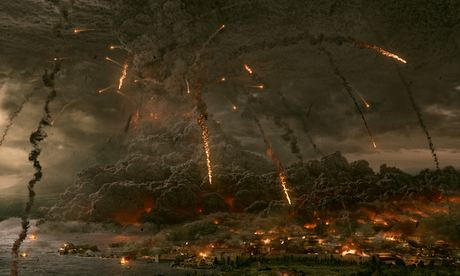
The ancient city of Pompeii has been recreated with astonishing attention to historical accuracy for an epic film about its destruction following the eruption of Vesuvius some 2,000 years ago. Advances in digital technology helped recreate the disaster convincingly and film-makers were also guided experiences of recent tsunamis.
British director Paul WS Anderson recruited an army of craftsmen to reproduce every detail, from hand-shaped cobblestones to handmade wall paintings and mosaics, reconstructing buildings with the exact dimensions of those in the actual city. His team spent six years researching Pompeii, imaging the ruins and flying extensively over Vesuvius and other active volcanoes. A vulcanologist and a Roman historian were among the film's advisers.
Anderson told the Observer that, although Pompeii is "entertainment" rather than documentary, accuracy became an obsession – even down to baking loaves like those found preserved in the volcanic ash, stocking a fish stall only with species that the Pompeiians are known to have eaten, and reproducing costumes from paintings.
Pompeii, a UK-Canadian co-production, will be released in British cinemas on Wednesday. It stars Kit Harington, a lead in the epic TV series Game of Thrones and the National Theatre's hit War Horse, in a story of gladiatorial rivalry, political intrigue, star-crossed lovers and a terrifying struggle for survival as Vesuvius erupts and Pompeii disintegrates.
Anderson, whose films have grossed more than $1.5bn and include The Three Musketeers with Orlando Bloom as well as the Resident Evil series, has been obsessed with the Romans since childhood. He grew up in the north of England, close to Hadrian's Wall, and says "the Romans were a big part of my life as a kid".
His producing partner, Jeremy Bolt, said: "Just 15 years ago, it would have been much harder to make this film, but the advances in digital technology allowed us to recreate AD79 Pompeii much more convincingly."
It meant that they could reproduce the full forces of the disaster – an earthquake, volcanic eruption and the final deathblow, a tsunami. Referring to contemporary witness description by Pliny the Younger, Anderson said: "His writings were actually so compelling and graphic that for a while he was quite discredited because people just didn't believe something like this could happen." Anderson is pleased that the movie features the tidal wave "because Pliny talks very graphically about the water in the Bay of Naples sucking out". Recent experience of tsunamis was also studied.
The top of Mount Vesuvius blew off with such force that its height was reduced by 600m, its effects comparable with a nuclear blast. An avalanche of hot ash preserved Pompeii for posterity. The film's fictional characters were inspired by preserved bodies, contorted with fear.
Film sets included an opulent villa, entire streets, the amphitheatre and forum. Anderson said that a laser scan of Pompeii's ruins enabled extraordinary precision. He said that the streets his team recreated are exactly the dimensions of Pompeii. The city architecture was completely accurate, he said, as was the computer-generated version of the city geography.
He sought to show the sophistication and opulence of life in Pompeii before its destruction, and to reflect how advanced the Romans were. "[Today], occasionally, you get underfloor heating in the bathroom. The Romans had that 2,000 years ago as standard with most of their villas, and fresh water and plumbing on the second floor of buildings. They really were an incredibly technologically advanced society and yet, in the face of Mother Nature, it just didn't mean anything. That definitely has parallels to teach us in the modern day."
Reading on mobile? Watch the Pompeii trailer here
Jonathan Edmondson, the British-born professor of Roman history at York University in Toronto, advised on the film's historical accuracy. He said: "There are a lot of strengths to it. I was very impressed with Paul's keenness to get things right. He did accept most of my major criticisms. The biggest change was over many of the names of characters which in the original script were impossible. Either they weren't Roman or they hadn't understood how Roman families worked, with children taking on the father's name. The original script had them feeding potatoes to the gladiators. I pointed out [that], at that time, they'd not heard of Walter Raleigh."
There was some artistic licence. Anderson could not, for example, risk his actors riding horses without stirrups. But, in a bid to limit computer-generated imagery, actors did endure extreme physical demands. Anderson said: "A lot of what you see is real. The actors are in there with the flames and ash. Unpleasant for them, but very realistic."
Edmondson said that films such as Gladiator have played a part in exciting public interest in Roman history. His university has seen stronger enrolments as a direct result, he said: "Not many high school children read books these days. Theirs is mainly a media world."
For that reason, film-makers need to be all the more responsible with history, he said: "I was horrified by the Troy movie, which completely rewrote the story and made it ridiculous. Gladiator did take some liberties with details, but worked as a movie." Although, like some US critics, he feels Pompeii's storyline is "a bit predictable", like most, he was impressed with the final sequence of eruptions and the attempt to escape, which he calls "exciting and gripping".

